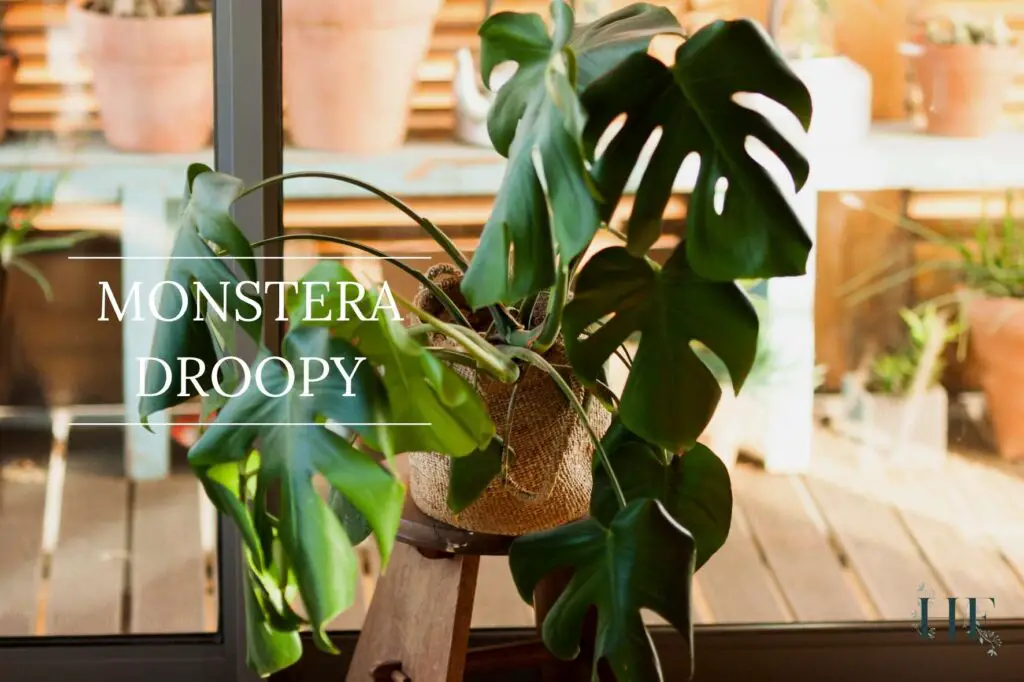Although Monstera plants are typically quite hardy, you may find yourself dealing with a droopy Monstera or a Monstera with floppy leaves.
The trouble with droopiness is that, like yellow or brown leaves, it can have many different causes. However, in most cases, it’s quite easy to revive a droopy Monstera.
Droopiness is usually an early warning sign of problems, and it doesn’t damage the leaves, so your plant will almost always be able to make a full recovery! Find out the potential causes of droopiness in Monsteras and how to fix (and prevent) them.
Causes of Droopy Leaves in Monstera
Why is my Monstera droopy?
Droopy or floppy leaves in Monstera is most commonly due to lack of water (an underwatering problem). But other causes include low light, temperature stress, overwatering, overfertilisation, stress after repotting, lack of support, shock after pruning and propagation, and pests.
If you notice your Monstera’s leaves wilting or the whole plant drooping (i.e., your Monstera isn’t its usual perky self), identifying the problem is the most important step to nursing your plant back to health.
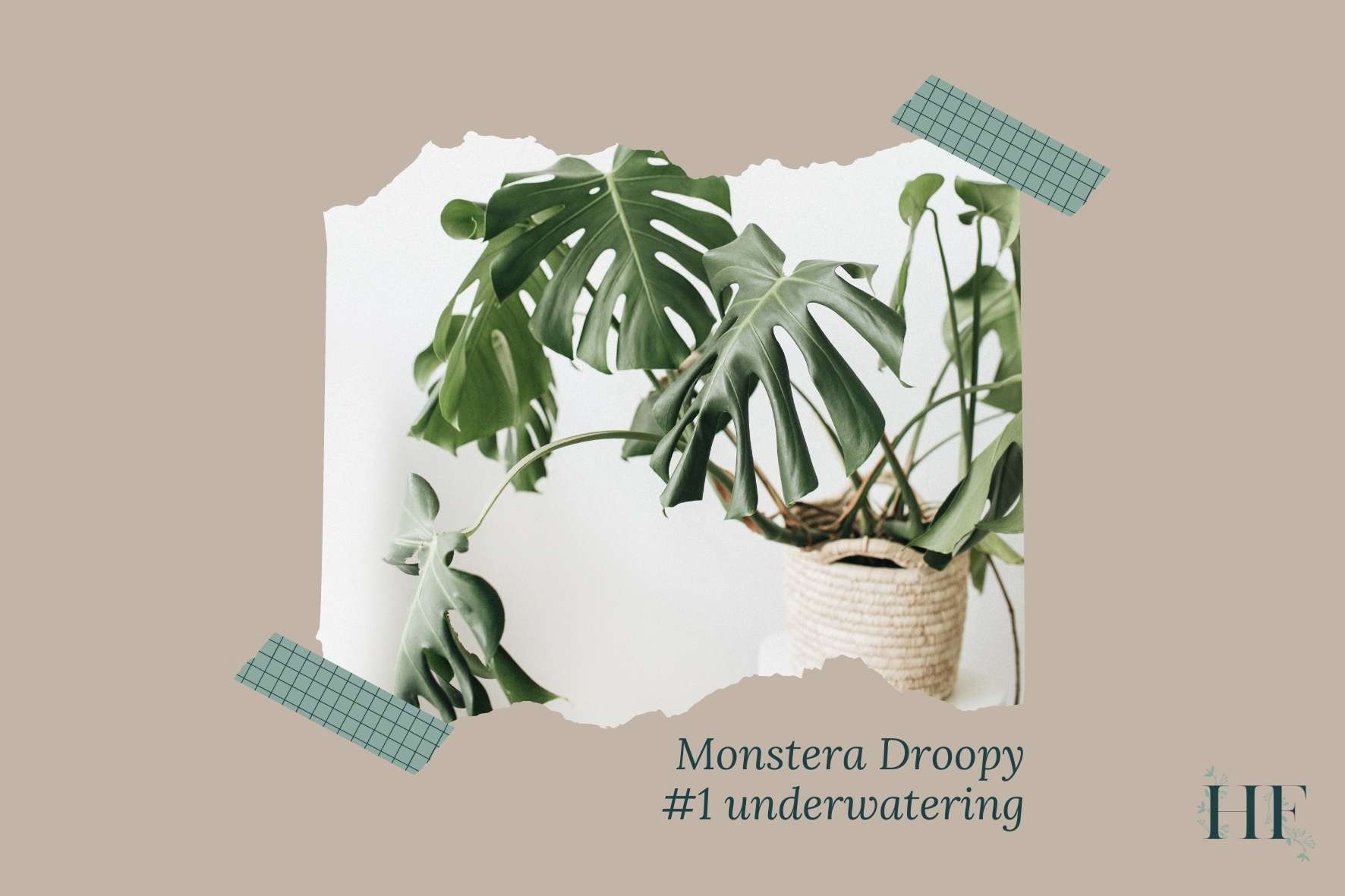
1) Underwatering
First, check the moisture levels in the soil using a moisture meter (this is the one I use and recommend). If the soil is dry more than a few inches down or reads dry (1-2) on your moisture meter, your Monstera plant needs water.
When your Monstera is underwatered, the soil is dry. Also, your Monstera’s leaves will turn yellow first and drop. Then, they will turn brown or get dry (crispy) brown spots or patches on their leaves.
Thankfully, underwatering is easier to fix than overwatering (and much less likely to kill your Monstera).
How to Fix Underwatering
If your Monstera leaves are drooping and turning yellow or your Monstera leaves are drooping and curling, and the soil is dry, you can prune the affected leaves and water your plant thoroughly. Your plant will recover and those droopy leaves will perk back up.
How to Prevent Underwatering
Always check the soil first before watering, regardless if you are following a watering schedule or not. Also, adjust your Monstera’s watering schedule to be more frequent to avoid underwatering issues in the future.
For more, read A Guide to Monstera Water Needs (How Often and When).
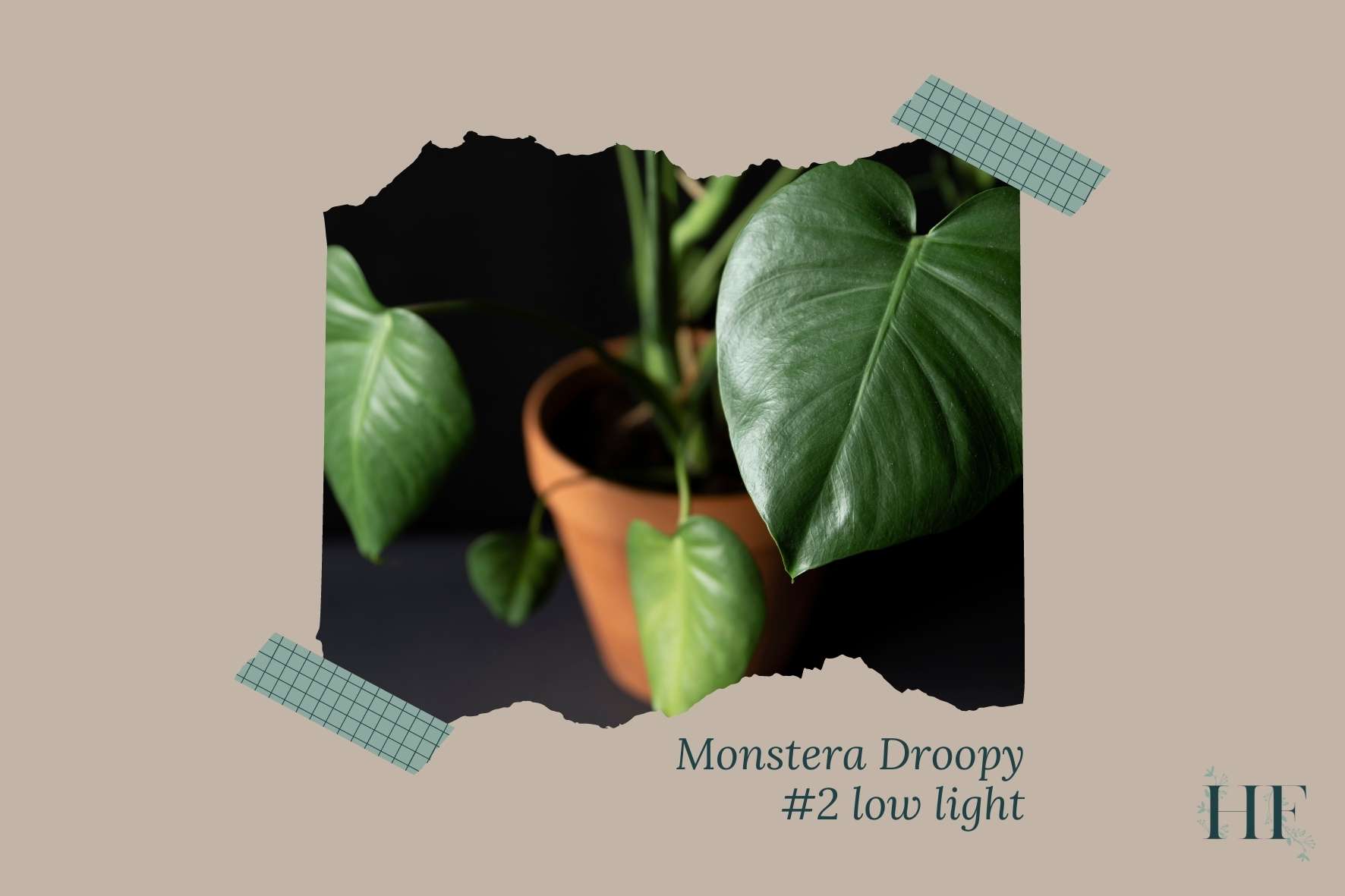
2) Low Light
Monsteras need plenty of bright, indirect sunlight to thrive, and they may start to droop if they don’t get enough.
Low light will cause your Monstera to become leggy (stretched, with sparse foliage), and more prone to droopiness.
Signs of light deficiency include:
- Leggy growth – elongated stems.
- Smaller leaves with less fenestration (holes and splits) or none at all.
- Weak aerial roots.
- Slow growth.
- Soil takes a long time to dry out in between waterings (which can lead to overwatering and root rot).
How to Fix and Prevent Low Light
If your Monstera leaves are drooping, relocate your Monstera to a brighter spot, ideally 2 to 4 feet (0.6 to 1.2 m) away from a bright window that is either facing east or south.
Also, your Monstera should get at least 6 hours of bright indirect light naturally. If that’s not the case, you can supplement its light needs with grow lights. Always go for a full-spectrum grow light (this one comes with a timer and you can clip it to a shelf). If you already have a lamp, you can get a Sansi bulb, which is affordable and does a good job too.
Finally, if you are unsure about how much light your Monstera is getting, you can use a light meter to check.
For more, read Monstera Light Requirements – How Much Does It Need?

3) Temperature Stress
If your Monstera experiences an abrupt temperature change, usually going from warm to cold temperatures very quickly, its leaves are likely to droop. Also, cold drafts can cause considerable stress and lead to your Monstera leaves drooping.
Apart from droopy leaves, other signs of cold damage include:
- Burnt and brown leaves (due to frostbite).
- Leaf discolouration.
- Plant wilting.
- Blackened foliage.
- Loose root ball.
High temperatures and low humidity can also cause droopy and curling leaves on Monstera plants.
Other signs of high temperatures and low humidity:
- Brown tips or spots on the leaves (due to sunburn).
- Yellowing leaves that feel dry to the touch (crispy texture).
How to Fix and Prevent Temperature Stress
If your Monstera leaves are drooping and curling, assess both temperature and humidity levels. You can use a hygrometer (which is what I use). This will allow you to adjust your Monstera’s growing conditions accordingly.
Also, assess your Monsteras’ location:
- Is it next to a west-facing window where it gets strong afternoon sun?
- Is it next to a cold, drafty window in the winter?
- Is it next to the radiator or an air conditioner?
When that’s the case, it would be best to relocate your Monstera where the temperature will be more stable.
Remember that the ideal temperature range for an indoor Monstera is between 20 to 30°C (68–86 °F). Below 13ºC (55°F), a Montera’s growth will slow down and temperatures below 10ºC (50°F) can shock and kill your plant.
Finally, make sure that your Monstera is getting enough humidity, at least between 40% to 60%, preferably 60% or above.
For more, read Monstera Humidity & Temperature Needs – 7 Tips to Get It Right.
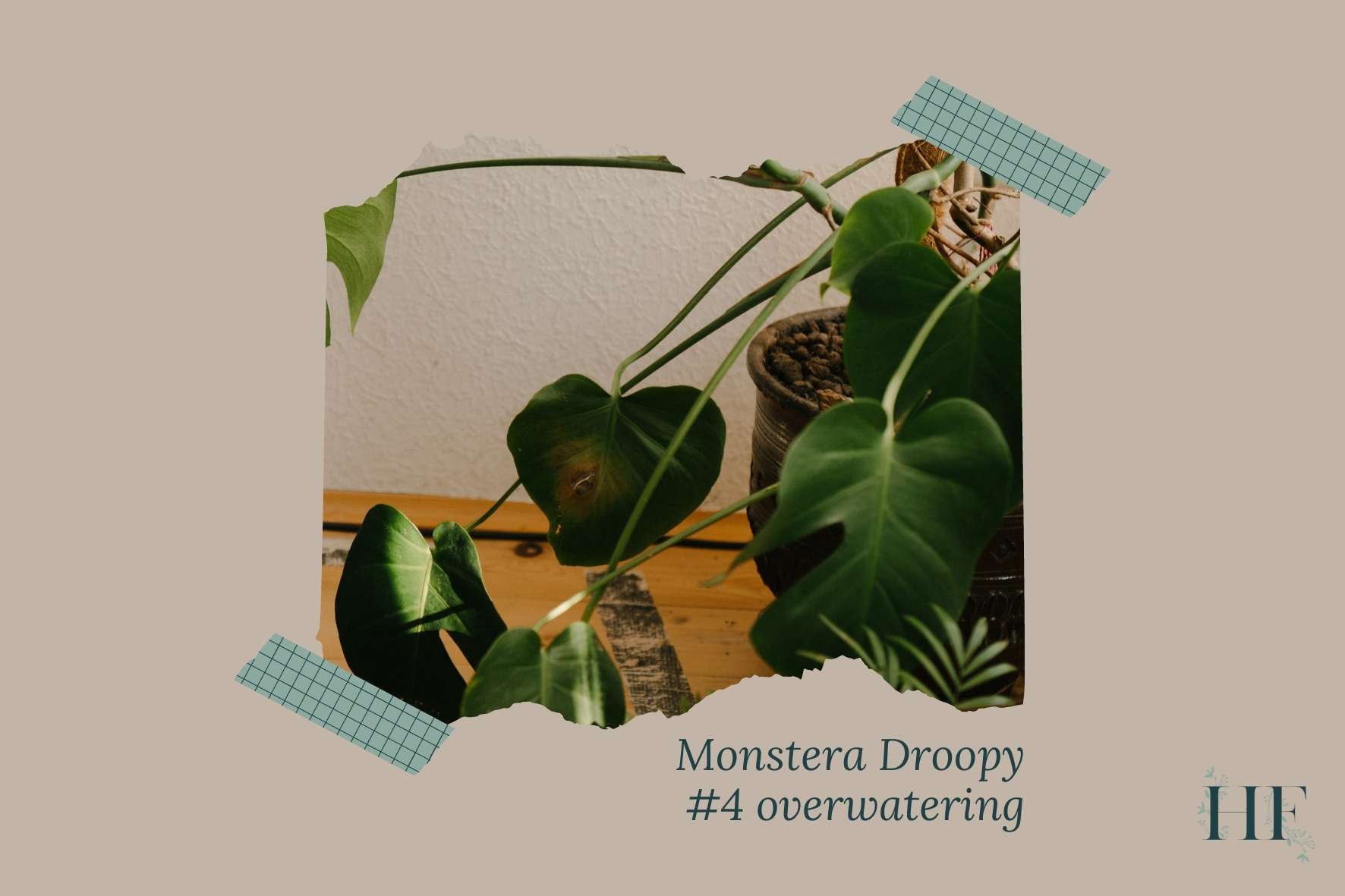
4) Overwatering
Both overwatering and underwatering can cause your Monstera to droop, although underwatering is a more common cause. To determine which one of these might be the problem, check the moisture level of the soil using a moisture meter (the most accurate method to determine how much water is in the soil).
If the soil is wet, less than 2 inches below the surface or reads wet (8-10) on your meter and you haven’t watered for a few days, your Monstera is overwatered.
When your Monstera is overwatered, the soil is wet. Also, your Monstera’s leaves will turn yellow and wilt (drop). Then, they will develop soft dark brown or black spots on those yellowing leaves (which is also a clear sign of root rot).
How to Fix Overwatering
If your Monstera plant is a little overwatered and not showing signs of root rot, simply give it a chance to dry out before watering it.
But, if your Swiss Cheese Plant is suffering from root rot, likely if you are seeing those soft brown spots or areas on the leaf, you will need to repot your Monstera as soon as possible, using a potting mix with better drainage.
Remember that overwatering is due to watering too often (especially during their dormant period). It can also occur due to heavy, poorly drained soil, oversized pots, or lack of drainage. If left to its own device, your Monstera will likely die.
How to Prevent Overwatering
Only water your Monstera when the soil is dry, which means that you need to check the soil first before watering your plant.
Also, make sure that the potting mix and pot material and size are adequate for your plant.
For more, read Monstera Root Rot Signs, Causes and Recovery Tips.

5) Overfertilisation
When your Monstera is overfertilised, its leaves wilt or drop.
Other signs of overfertilisation include:
- Leaves turning yellow and brown on the edges.
- A white crust on top of the soil.
- Slow or stunted growth.
This is due to salt build-up in the soil as a result of fertilising your plant too often or too much. The salt content alters the pH of the soil and causes salt burn (turning your Monstera’s leaf edges brown and crispy).
How to Fix Overfertilisation
If it’s an overfertilisation problem, you can flush the excess fertiliser out by running water through the plants soil until it drains from the pot’s bottom drainage holes.
Afterwards, just make sure that your Monstera plant dries thoroughly before the next watering to avoid overwatering. Also, you may want to wait a little longer than usual before fertilising your Monstera again.
If the problem persists, you may need to repot your Monstera into fresh soil.
How to Prevent Overfertilisation
Reducing the amount and/or frequency of fertiliser is key to avoiding future issues.
To prevent being a little too generous with the fertiliser, consider switching to a gentler, organic fertiliser like this one, which has a lower concentration of macronutrients and therefore less likely to cause a salt burn.
For more, read A Guide to Monstera Nutrients (Why, When and How to Fertilise) – which includes a variety of fertilisers and explains which ones are more appropriate for Monstera plants.
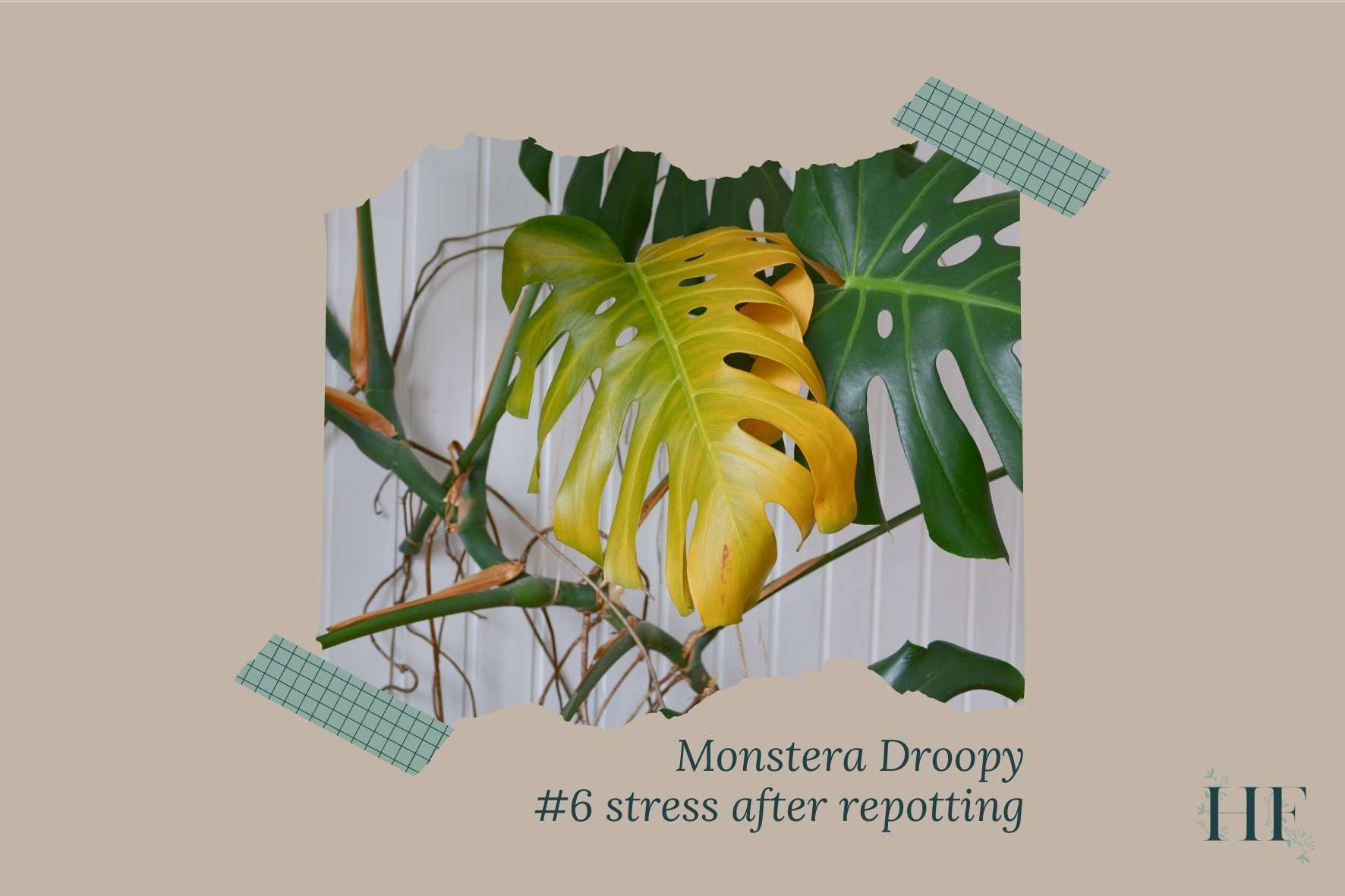
6) Stress After Repotting
If your Monstera leaves start drooping after repotting, it’s due to transplant shock.
Repotted Monsteras can suffer from transplant shock due to the roots being exposed for too long, a change in soil, or even repotting at the wrong time of year (early spring is best).
Plants don’t move around in nature, so being moved or repotted is a big deal!
Other signs of stress after repotting include:
- Yellow leaves.
- Brown leaves.
How to Fix Repotting Stress
Your Monstera will need some time to adjust to its new soil and pot, but it will bounce back to normal. Usually, it will perk back up on its own in a week or so.
Placing your plant back in its original location and maintaining the same growing conditions lessens the chances of transplant shock.
Also, it’s best not to fertilise for the next month since this can prevent the new roots from being burned.
How to Prevent Repotting Stress
Next time you repot your Monstera, here are some ways to minimize your plants distress:
- Try not to disrupt the roots too much when you remove your Monstera from its old pot, moving as many of the roots intact as possible to the new pot.
- When you take the Monstera out of its pot, don’t remove or shake away any soil attached to the roots or injure the root ball.
- Do your best to keep the root ball moist while it is out of the pot. A dry root ball can lead to damage.
- Once your Monstera is settled in its new pot, water it thoroughly. Giving it plenty of water can help it settle into its new environment (pot and fresh soil) and reduce the risk of transplant shock.
For more, read A Guide to Repotting Monstera (When, Why and How).

7) Lack of Support
As your Monstera matures, its stems and leaves get bigger and heavier too. Without adequate support, your Monstera will grow sideways and droop due to gravity. Your Monstera stems will bend and arch to the side, giving it a droopy look.
How to Fix and Prevent Lack of Support
If your Monstera is falling over, growing sideways or trailing over the side of the pot, it is time to start thinking about adding support.
By providing a support structure such as a moss pole, coco coir pole, or trellis, you can encourage your Monstera Deliciosa and Adansonii to grow upright.
Also, training your Monstera allows the plant to follow its natural inclination for climbing and can lead to a healthier plant with larger leaves.
A moss pole, an extendable coco coir pole and a bamboo trellis are amongst the most common Monstera support systems or structures.
For more, read A Guide to Monstera Training – How to Make Them Climb – which includes more support ideas!
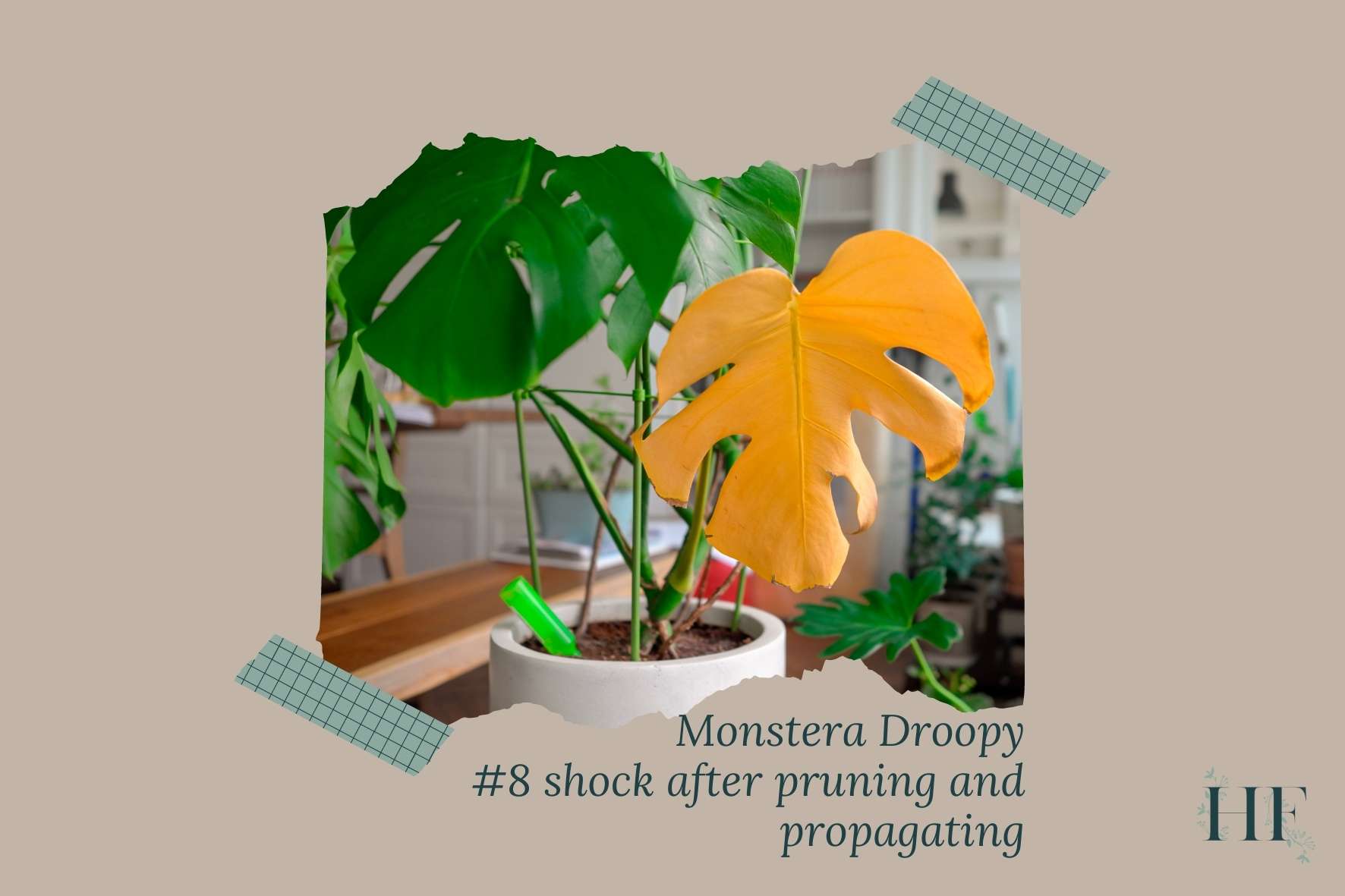
8) Shock After Pruning and Propagation
Pruning or taking a cutting from your Monstera can also cause shock. If you recently pruned or propagated your plant, this is the likely cause of drooping.
How to Fix Shock After Pruning and Propagation
If your Monstera leaves are floppy after pruning and propagating, your plant just needs time to adjust to change (like the repotting stress scenario). So, the best course of action here is to do nothing.
Just make sure that your Monstera is getting plenty of bright indirect light and consistent care, and it should be back to its old self in a week or two.
How to Prevent Shock After Pruning and Propagation
Pruning should be done in early spring before the Monstera enters its growing season. This ensures your plant will have the resources it needs to recover from any stress or damage from pruning and be ready to send out a flush of new growth.
Spring is also the best time of year to take cuttings from a Monstera to propagate for the same reason.
Avoid pruning and propagating your Monstera in autumn and winter since it’s the worst time to do it. This is when Monsteras enter their dormancy period and there is simply inadequate sunlight for photosynthesis to fuel growth and repair damage.
Lastly, when pruning, it’s best not to cut away more than 25% of the stems at any given time since it can weaken your Monstera plant.
For more, read A Guide to Monstera Pruning (How, When and Why) and A Guide to Monstera Propagation in Soil, Water and more!
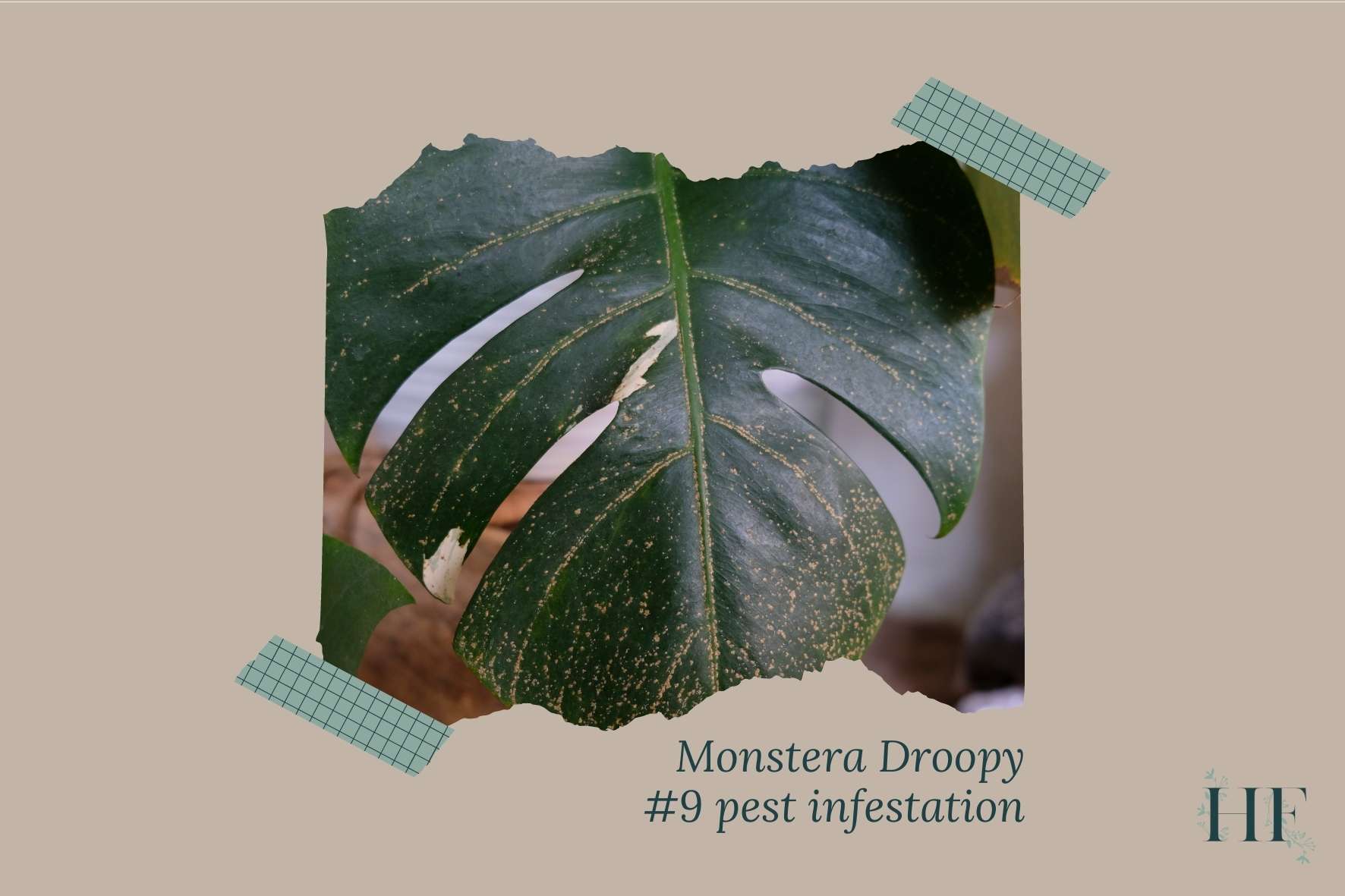
9) Pest Infestation
A bad pest infestation will cause the plant to lose considerable water and nutrients through the injuries on its leaves, resulting in your Monstera leaves drooping.
Insects like spider mites, mealybugs, aphids, fungus gnats, etc., suck the juices out of your Monstera’s leaves and stems, causing it to droop and get yellow spots on its leaves.
How to Fix Pest Infestation
If you notice droopiness along with small yellow spots, cottony webbing, sticky residue (honeydew), or actual insects, you will need to act fast to stop the infestation.
First of all, isolate your Monstera plant from other houseplants to avoid the pest from spreading.
Then, you can wash your plant using a soap and water solution to get rid of pests.
Insecticidal Soap Recipe: Dilute a tablespoon of unscented dish soap (I use this one, which is free of harsh ingredients) diluted in a gallon of water (4.5L). Then dip a soft cloth in the solution and clean off the infestation. You can also spray the solution using a spray bottle.
Alternatively, neem oil also works well to get rid of pests.
Neem Oil Fungicide Recipe: To use neem oil as a fungicide, mix a teaspoon of neem oil with a quarter of a gallon (1 litre) of water. Then add a couple of drops of dish soap to emulsify the mixture, and mix well. After, you can apply this mixture with a spray bottle or wipe the affected areas using a soft cloth.
You might need to repeat either of these treatments until you get rid of the pest infestation completely.
How to Prevent Pest Infestation
Perform a routine check to keep pests at bay. Check the tops and undersides of your Monstera’s leaves regularly as it is always easier to deal with plant pests before they spread to the whole plant or become established.
For more, read 11 Monstera Pests and Diseases Plus How to Get Rid of Them.
Related Questions
Will Droopy Monstera Leaves Recover?
In most cases, it’s quite easy to revive a droopy Monstera. When droopiness is an early warning sign of problems, and it doesn’t damage those leaves, your Monstera will be able to make a full recovery on its own.
When a droopy Monstera shows other signs apart from floppy leaves, you will need to find the cause to be able to fix the underlying problem and prevent it in the future.
How Long Does It Take for a Monstera to Stop Drooping?
How long it takes for your Monstera to recover will depend on what is causing it to droop.
When the only sign is droopiness due to underwatering, transplant or pruning shock, your Monstera will usually perk back by itself after one to two weeks. However, note that some plants might take up to a month to recover from the shock.
Should I Remove Drooping Leaves?
Unless the leaves are actually damaged (yellow leaves, brown leaves, full of spots, etc), there is no need to prune them. As long as the leaves aren’t discoloured or damaged, they should perk back up.

